Norway: climate and ingredients
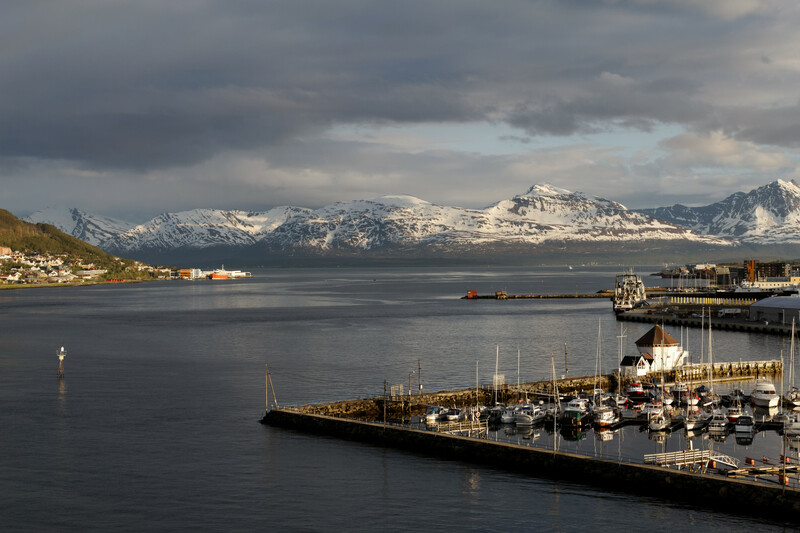
Tromsø, northern Norway, in June |
Norway may not be the world's biggest country, but it has considerable geographic variation. This is mainly due to two factors. First, Norway is long and narrow, going roughly north-south. From the northernmost point to the southernmost point is 1700km, or roughly the distance from Manchester to Rome. The climate is fairly northern already in the southern part of Norway, and you can imagine what it's like 1700km further north.
The other main factor is that southern Norway (the "thick" part south of Trondheim) has a mountain chain running through it. The prevailing weather comes in off the North Sea, which means that the sea wind brings a lot of humidity and in summer cooler temperatures. (In winter it keeps things warm.) The mountains not only block the wind, but also cause clouds to rise when they hit the mountains, which cools them and tends to make them drop their rain west of the mountains. This is why Bergen is one of the rainiest cities in Europe.
So, for simplicity, you can split Norway in three parts. North: cold, mountainous and for the most part not very amenable to agriculture. West: humid and cool in summer, so not ideal, either. East: relatively warm and not too humid, about as good as it gets for agriculture at 60 degrees north.
The consequences can be summarized very briefly: wheat has been grown in Norway for a long time, but until the last half a century or so it was in very small amounts. Barley has been the main crop in Norway ever since the introduction of agriculture. However, barley doesn't like the wet western climate, and so oats was always the main crop in the west. Rye was mainly grown on rather marginal land.
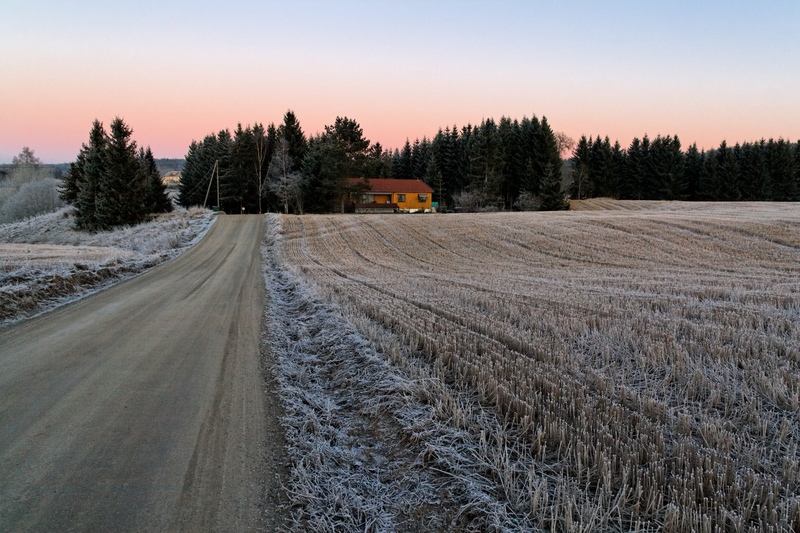
Farming in eastern Norway (Østfold) |
This had consequences for the beer. People generally did not much approve of oats for beer, so on the west coast people would set aside the most suitable small field for barley for the beer. Or they would trade it from their neighbours, or even buy it in the city. Some reponses say they bought Danish or Baltic barley. Thus, for beer barley dominated even in the oat belt.
Looking at the farmhouse ale survey we get the distribution shown on the map below. Colours:
- Green means just about everybody brewed mostly pure barley beer.
- Yellow means there was a mix with oats, and some people might brew with just oats, even if barley was preferred.
- Blue means they used only rye.
- White means they used a mix of barley, oats, and rye.
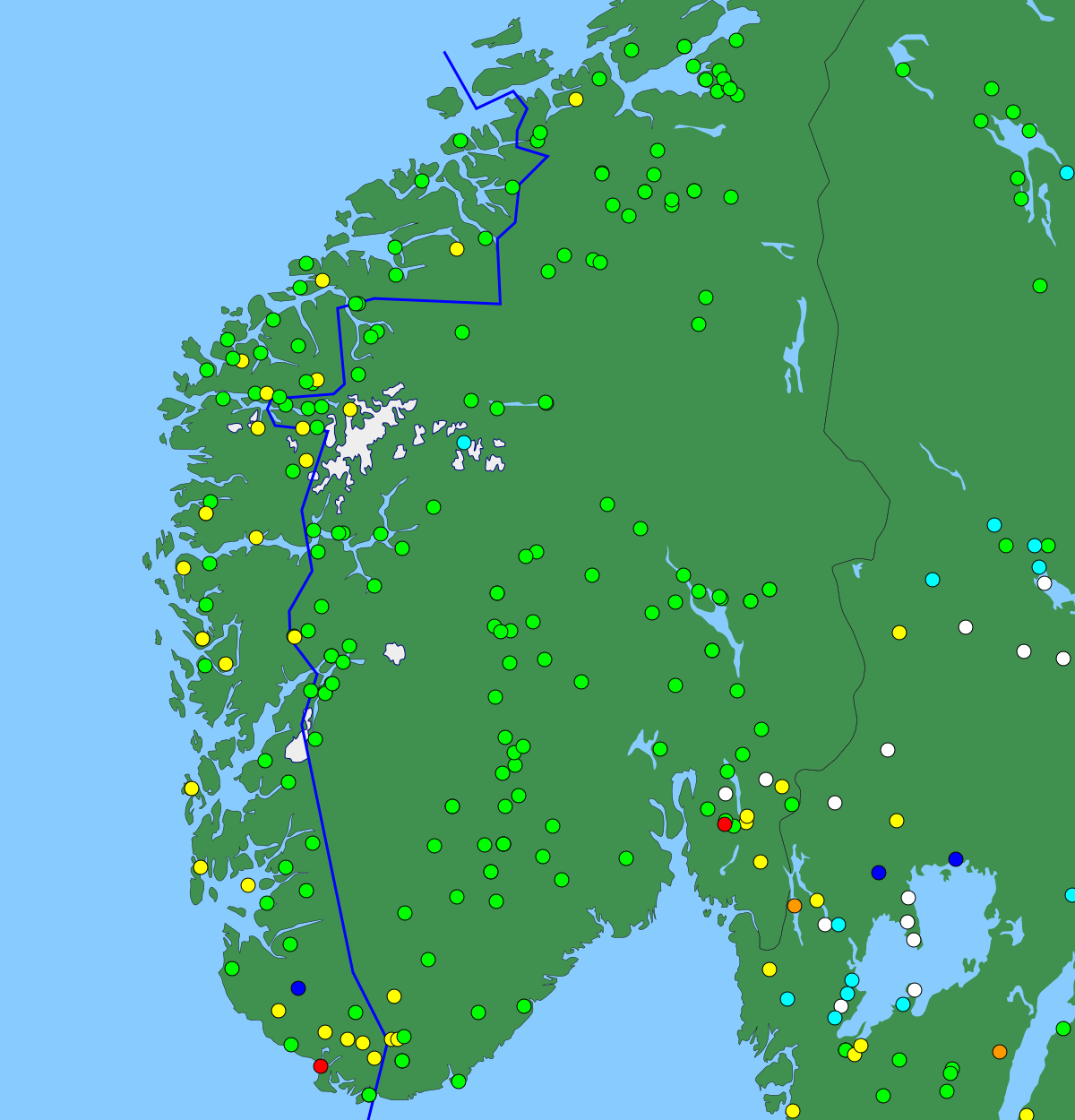
Grain use map with Hasund line |
The red line I've taken from a paper (Hasund 1942) that used the tax surveys of 1667 and 1723 to find out where people grew oats and where they grew barley. (Oats was west of the line.) You can see that the yellow dots for mixed barley/oats are mainly west of that line. As a rule, responses from west of the line describe how people got hold of barley, while responses from the east of it curtly dismiss the issue ("only barley is grown here", "they used only barley") or they even express mild incredulity at the question. As in, "why would anyone make beer from oats"?
The cluster in the south-east is interesting. It reappears on the next map, too. Barley didn't grow too well on the coast in eastern Norway, either, so it might be the same effect there, but those dots are pretty far inland, so I'm not sure.
Very likely these climatic differences will have caused differences in flavour, too, but those are long lost now.
It's worth noting that the places where brewing has survived into the present day are nearly all west of the mountains, but east of the oat line. The exceptions are Stjørdalen and a few places just west of the oat line in Sunnmøre.
Hops are fond of sunlight, and so don't like to be too far north. Norway has a very mild climate for being at 60 degrees, so hops do grow here, but the cool humid cloudy weather in the west is not ideal for them. As is indeed clear from the map below, which shows where people grew their own hops (green), bought the hops (red), or did a bit of both (yellow).
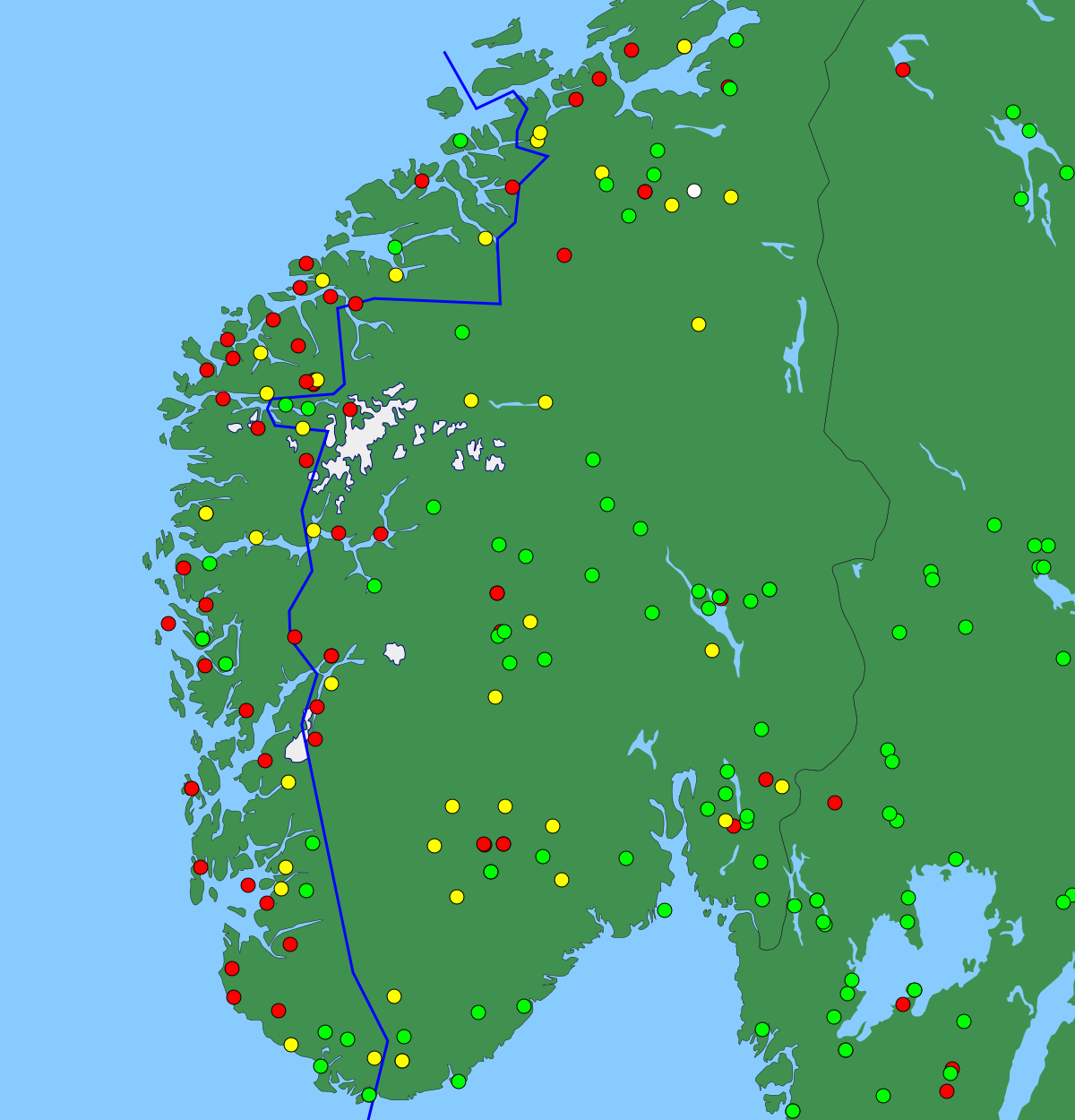
Hop growing map with Hasund line |
The correspondence with the oat belt is no longer as good, but you still get the impression that the western climate was not good for hops. They'd stopped growing them other places, too, in large part because of convenience. Opinions seem to be divided over whether shop hops or local hops were best, but hops were so marginal in Norwegian farmhouse ale anyway that I'm not sure it mattered much.
I'm not sure where the hops they bought in the stores came from. In the southern parts of Norway some responses mention selling the hops to distributors or pharmacies, but there doesn't seem to have been very much of that. So very likely some of the hops they bought were imported, but probably not all.
Note that while barley was grown as far north as Bardufoss at 69 degrees north (the response is very clear on this), growing hops further north than Velfjord at 65 degrees north seems to have been hard. The yellow dot indicates they were grown around Bodø, and I seem to remember have heard about it in the nearby Lofoten Islands as well. Still, it was probably quite marginal.
Anyway, I thought this was an interesting look at the interaction between climate and beer. Obviously, the climate of the locale affected the local beer.
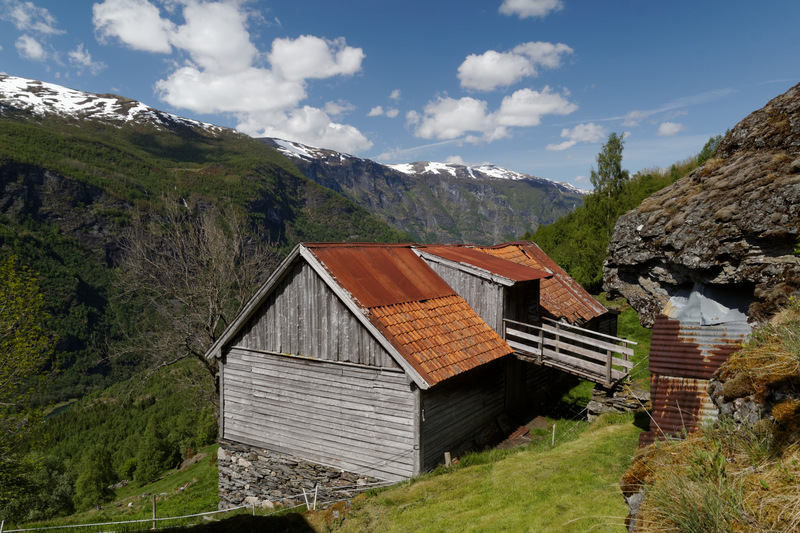
Farming in western Norway (Flåm, Sogn og Fjordane) |
Postscript
What I've published on this blog so far barely even scratches the surface of the survey responses, which run to 1264 pages all told, most of them crammed with information. In the course of the summer I hope to get hold of the results of two Danish surveys. I was planning to get a Swedish one as well, but that archive is closed for the rest of 2015. Next year...
There are also the Finnish, Lithuanian, and probably also Estonian and Latvian surveys, but I don't see how I'm ever going to be able to read those.
Sources
Norwegian Ethnological Survey, responses to questionnaire 35, "Ølbrygging", 1952.
Bygget som 'ølkorn' i det vestlandske havreområdet, Sigvald Hasund, in Or Norges Bondesoge, Glytt og granskningar, vol 1, 1942, p 208-226.
Norges Landbrukshistorie, volume 1, Øye and Solberg, Samlaget, 2002.
Similar posts
Norwegian brewing processes
I've collected enough evidence now that I'm beginning to get a picture of farmhouse brewing as it was practiced in Norway in the past
Read | 2016-12-11 20:01
Traditional malting in Morgedal
The guys I visited in Morgedal were definitely brewing traditional farmhouse beer, but they bought the malts
Read | 2015-11-21 13:09
Farmhouse ales of Europe
Having surveyed the state of farmhouse brewing in Norway it's time to look at the same thing in Europe generally
Read | 2014-10-18 16:46
Comments
Dave Pawson - 2015-05-19 10:50:45
Ah, but it is Oh so pretty in the North. What fields there are, may be tiny and hug the fjords, but it's a magic carpet ride through the Northern fjords :-)
Lars Marius - 2015-05-20 02:05:40
@Dave: Certainly the north in beautiful. It's really magical at the best moments. But I wouldn't want to grow barley there. :)
OliverH - 2015-05-24 08:16:18
I really enjoyed this, thanks.
Robert Hogben - 2015-06-01 15:14:29
Once again a most interesting article,well presented.Your blog has certainly introduced me to new perspectives.
I find the idea of growing hops so far north mind boggleing.How about more on that subject historical and current when you get some time? regards Robert
Åsmund M. Kvifte - 2015-06-03 10:52:44
Regarding the brewers in Østfold, where some use barley and some oats: it is clay areas all (NGU deposit map), the need for drainage is much the same (Skog og Landskap's Kilden) and the climate is not that different down there. So I would guess it is social rather than natural reasons for the Trøgstad and Rakkestad oat brewers.
Maybe check average farm sizes?
Lars Marius - 2015-06-03 12:06:39
@Robert: Thank you. I might write something on hop-growing in the north if I can find something interesting to say about it. Right now I have very limited information, unfortunately.
@Åsmund: Excellent input, thank you! I looked over the survey responses again, and in Enebakk they say harvest failure might cause people to malt oats and rye, but even so there was a preference for barley with oats. The other responses are ambiguous, but may imply that the preference was social. So it does seem like you're right.
Tom - 2015-08-16 11:51:45
Thank you! Is there any information on the hop-varieties grown? I live in the SW of england and hops were grown here but the modern varieties dont work well so I was hoping to track down some that would.
Lars Marius - 2015-08-16 11:57:04
@Tom: The hops were local Norwegian varieties. Unfortunately, Norwegian hops don't have type names, because they were not grown commercially. They are not sold commercially today, either. I know that Bioforsk has a collection of plants from various places in Norway, and that they grow wild or semi-wild a few places in Norway. So your best bets are either finding a Norwegian home brewer willing to help or to contact Bioforsk.no.
Larry - 2016-07-11 14:31:43
Thank you! I recently visited Fjærland on our first trip to Norway. I asked our tour guide, who was a local, if anyone in the area brews their own beer? Her response was "well I brew my own beer, but it is for our own use and we don't sell it." She said her family brews every fall and uses juniper. Unfortunately I was unable to glean more information due to time constraints and language barriers. I have her contact information if you are interested. I have enjoyed your blog and appreciate all you are doing to record and preserve traditional farmhouse brewing.
Lars Marius Garshol - 2016-07-24 12:17:21
@Larry: Thank you for this. Very interesting! I didn't know there was brewing in Fjærland still. I've written to you by private email to get her contact information.